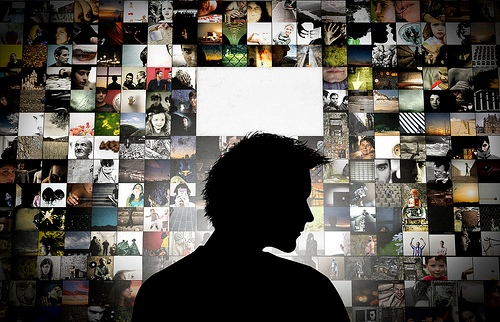A percussionist has a way of creating music out of a couple twigs and an iron pot. A dancer can turn an empty room into a mosaic of movement. Why not use your own inherent creative capacities to be the artist of your own life?
We often feel trapped; unable to change directions while on the roads we travel.
But just as a writer can overcome creative blocks when staring at a blank sheet of paper, we can all overcome the blocks that prevent us from seeing creative possibilities for our lives.
I was an electrical engineer for over a decade before I decided to make my own creative career changes — going back to graduate school and becoming a published author.
It was a process consisting of a lot of sweat, doubt, and frustration. As it turns out, lots of people go through the same process.
As I chronicle in my book, The Power of Thinking Differently, the creative process is similar across disciplines—from art, business, to scientific advancement.
It is also the same for those of us wanting to make creative changes in how we make a living and how we live our lives in general.
The following ten steps to creative career changes are adapted from both the research for my book and my personal experience. Though I’ll emphasize “career” changes, the steps can be applied to any life changes you may wish to make.
I hope it provides you with a useful map to wherever it is you are meant to go.
1. List Your Reasons for Change
Begin by taking an inventory of the negative stuff. What is it about your life that you would like to change? What about it makes you unhappy?
Be as specific as possible. Write a list consisting of short declarative statements that get to the point.
It’s often easier to first figure out why we want creative change, and what we are changing from, before deciding which direction to go.
2. List Your Passions and Skills
Over time, some of us stopped making life decisions based on what makes us happy. Instead, decisions were based upon the expectations of others. We ended up living our lives based on somebody else’s story of what a good life looks like, rather than following our own internal compass.
The result is your list from step #1.
Now it’s time to reclaim your life.
Start by listing what activities, hobbies, or aspects of your current job give you joy. What gets you excited just thinking about it?
You can take a look at your own personal history to get more ideas. Sketch out your autobiography to get a sense of your life’s highlights. When you were a child, you often did things because you loved doing them. What are some examples of this?
You can also take an inventory of all the things you were, or are, naturally good at.
At the end of this step you’ll have a collage of potential aspects of your new career.
3. Explore Crazy Career Ideas
This is the stage of the creative process where businesses brainstorm, where sketch artists doodle, and where scientists experiment and hypothesize. It is also the stage where you give yourself freedom to dream up crazy career possibilities.
Wanna be a writer? What kind — for a magazine, for a newspaper, a book, for film, or a blog?
Love traveling? How about being a tour guide, or working for an airline to get free flights?
Or how about combining traveling and writing and becoming a travel author?
Relax, have fun, and simply play around with nutty ideas. Mixing and matching, making connections between alien concepts, is how creative ideas come about.
It is also the key to turning what you love into how you live.
Write down as many ideas as possible. Try to connect as many of your interests and passions and skills as you can to form interesting ways of making money. The more obscure the better. You won’t have any competition in the market place.
The key to this part of the process is to get as many ideas as possible without judging their feasibility. Your ridiculous idea about selling crotchless briefs may lead you to your life’s work in humorous clothing design.
4. Prioritize & Choose
At this point you should have a list of great ideas that you’ll want to pursue.
Now you need to filter. Now you need to look at the ones you’re most passionate about and start to judge them for their feasibility.
Einstein wrote lots of papers that nobody ever found useful, and Picasso had books of sketches that were never turned into masterpieces. But both were able to use their wild explorations to arrive at some inspired works.
You can do the same. Pick an idea that you’re most interested in and focus on it in the steps to follow.
5. Clear the Path by Realizing Your Assumptions
For many of us, we fail to fulfill our creative changes because we feel we can’t. We feel that our circumstances make it impossible to change.
Now it’s time to really stare that assumption in the face.
Take a look at where you are in your life (#1) and compare it to where you want to go (#4). What obstacles stand in your way? Write down everything you think is preventing you from pursuing your crazy career ideas.
Our mind has a tendency to exaggerate our obstacles and fears. The door we’ve never opened before can seem scary simply because it leads to something unknown.
Going through the process of realizing what those obstacles actually are may reveal to you that the emperor has no clothes. The shadow in the wall of your bedroom may just be your bedpost, and not the boogieman.
Hopefully you’ll begin to see that there’s a lot less in your way than you first thought.
6. Challenge Your Assumptions
Also embedded within each obstacle you listed is an assumption about how the world works. By writing down a list of your obstacles, what you are really describing are your assumptions–the dominant stories you tell yourself about life.
Through our culture we’ve learned certain rules about how to make money, about how to find love, and about what careers are possible. But just as an artist breaks the rules of what good art should be in order to come up with something truly creative, we too need to challenge our assumptions in order to live more creatively.
The earth was thought to be flat until somebody had the audacity to challenge that assumption. Similarly, movies were silent until somebody asked, “does it have to be that way?”
7. Organize A Game Plan
Hopefully after going through steps #5 and #6 you have a pretty good idea of what real challenges stand in your way.
With this knowledge it’s time to strategize and organize your creative career change.
- Write out an end goal.
- List the actions steps you think you’ll need to take to get there.
- Then write out a schedule to keep yourself accountable for completing your tasks.
8. Recruit Help
Too often when I was making my own creative changes, I felt as if I had to do everything by myself. It was my life, so I felt that my journey was supposed to be a solitary one.
Not true.
My friends each have certain skills and attributes that were helpful in making my career change. Fortunately, a few of them were more than willing to lend a hand.
- You could have somebody help you fulfill some of your action items.
- You could also have somebody act as your project manager, making sure you are following through with your tasks on time.
- Or you can simply ask somebody to be an encouraging voice every once and a while.
Corporations organize teams to get stuff done. Why don’t you organize your own team to help you make your vision of a new career a reality?
9. Execute Your Plan
The creative process is often filled with failure and setbacks.
It’s a very recursive process: one experiment leads to failure, which then leads to re-evaluation, and then leads to a more promising direction. There are no foolproof paths for your career.
Just realize that failure is just feedback. It’s a data point to help clarify your end coordinates.
Also, be aware that any movement is better than no movement. You can’t sail to your final destination until you first begin to leave the shore.
So, feel good about even the smallest steps realizing that most people never even leave their islands.
10. Keep Your Motivation Fueled
In a survey of creative people, the biggest contributing factor to their creativity was intrinsic motivation — how much they enjoyed what it is they were working on.
Throughout your creative process, find ways to keep your motivation fired up and burning.
Sometimes this means spending time remembering how much you disliked your previous career – hence your list from step #1. Pain can be more powerful than pleasure. So recalling this pain may be just the fuel you’ll need to keep you going.
Second, try to have fun with your journey to a new career. The more stressed and worried you are about your new adventure, the less enjoyable it will be. Also, stress hampers your ability to see more creative choices and creative insights that may help you along the way.
Making career changes can be very scary and may even seem like an impossibility. However, with courage, creativity, and a continued remembering of why you want to change, a new career is within your grasp.
*Note: I’ve done my best to keep these steps as general as possible. Please feel free to comment below and ask me specific questions for clarification. I’d love to hear from you.
Photo by Tiago Ribeiro






Great article! I think allowing yourself to explore “crazy ideas” and then really examining the limiting beliefs and assumptions we subconsciously hold can really open the door to radical and enlivening career changes. Thanks for sharing this.
Thanks for this Javy. It is important to be open minded and challenge the possible careers that one might think they can only do. You provided some very useful tips on exploring possibilities to have a more creative career change in one’s life.
Thanks, Miche and Tristan. I’m glad you found this useful. I hope people are able to apply this type of thinking beyond “career changes” and into other aspects of their lives as well.
Great game plan. I like how you go from thinking/playing to choosing/planning and then ending with action, which is the part many people forget to include.
For me #7 and #9 are huge roadblock sometimes. getting and asking help is a good tip, I should do that.
Hey Javy,
this is the perfect post for me because I am struggling to find what it is I am passionate about. And so far, it feels comforting to see someone else also agreeing to do some crazy choices and explore, because that is what I am currently trying to do.
I especially how you make the point for keeping up your motivation the last point. It is extremely important to have the motivation for anything, especially career-wise. You’ve provided some good tips on keeping up the motivation (I sure hated my last job! >:()
Thanks Javy, enjoyed the article.
Steven
I think that we often get stuck in the idea of picking “standard” careers based on what others think will be best. But life can be so much more fun when you’re doing something that’s a great match to your personality–even if it’s a little quirky. Wonderful article!
A really well written and helpful post. Some good tips to encourage us to ‘think outside the box.’ There really are no limits to what we can do if we get creative in our thinking.
Alex, it’s funny which aspects of the creative process people neglect. Some people think it’s all about coming up with crazy ideas, but crazy ideas can’t become a reality unless we use skills to manifest them into a painting, or an actual new career. The biggest thing is to know oneself. That way we can either develop the skills we lack (brainstorming for some, organizing for others) or get help from those that have those talents naturally.
Steven, I hope you come to remember what you love to do. I really believe the world will be better if you followed your natural path, sharing your natural gifts with others.
Hi Javy,
Well this definitely feels like a New Year!! self discovery channel for me. A good write indeed. Its refreshing too see familiar muddled thoughts in a neat order.
Thanks a ton!!
Keep up the good work.
Nice arranged. It makes a whole lot of sense to me. Thanks Javy.
Constructive information with the perfect amount of generalization to keep it applicable to anyone changing careers — or even those choosing their first career. Going through the first steps in this list would be a good exercise for high school seniors.
I love your blog and tips. They are really helpful for anyone and everyone looking for a new job. I hope you don’t mind I linked to your blog on my most recent post about my personal journey in changing careers and landing a great job!
Great tips! I also deal with those in change – Transitioning Teachers – and those not looking to find a ‘job’ but a career. As you pointed out it takes courage to allow yourself the freedom to think creatively – and this way of thinking and approach to answer the question What’s next? In the long run this path will be what brings the greatest satisfaction and rewards. As a former dancer, educator and now business strategist I have made the paradigm shift and if it were not for my ability to embrace experimentation – the process of creativity – I would still be stuck.
Going through a career change is difficult.You need to learn how to adapt to the changes in your surrounding in order to survive. But with patience and perseverance, things will be fine. Great post btw!
Thank you!I’m an engineer desperately wanting to change my career to something more creative related to arts, questioning myself each time if its worth it and if I should really go ahead with it. I’ve been trying to get an insight about changing career and no other article on the internet was as clarifying as this one!At least now I know that I want to be a graphic designer and although it seems difficult, hard work and my passion for art will get me there!Thank you for the wonderful advice!
Very good article and it referesh my mind as I am looking for a career change.
Love this article. Challenge your assumptions is spot on. You need to be mindful that everything you have been conditioned to think, may in fact be a false assumption. That’s what I am currently doing. You in essence need to find evidence for these assumptions. More often than not, you will find you have erected some barriers which simply aren’t present.